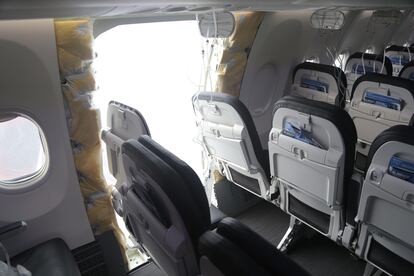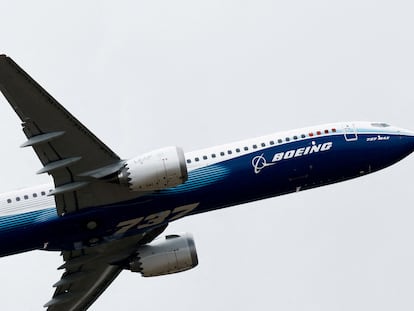Boeing jetliner that suffered inflight blowout was restricted because of concern over warning light
Shares of The Boeing Co. tumbled 9% at the opening bell Monday, the first day of trading since the incident occurred

The Boeing jetliner that suffered an inflight blowout over Oregon was not being used for flights to Hawaii after a warning light that could have indicated a pressurization problem lit up on three different flights.
Alaska Airlines decided to restrict the aircraft from long flights over water so the plane “could return very quickly to an airport” if the warning light reappeared, Jennifer Homendy, chair of the National Transportation Safety Board, said on Sunday.
Shares of The Boeing Co. tumbled 9% at the opening bell Monday, the first day of trading since the incident occurred. Shares of Alaska Airlines slid 4% and Spirit AeroSystems, which builds the fuselage for Boeing’s 737 Max, plunged 14%.
Homendy cautioned that the pressurization light might be unrelated to Friday’s incident in which a plug covering an unused exit door blew off the Boeing 737 Max 9 as it cruised about three miles (4.8 kilometers) over Oregon.
The warning light came on during three previous flights: on Dec. 7, Jan. 3 and Jan. 4 — the day before the door plug broke off. Homendy said she didn’t have all the details regarding the Dec. 7 incident but specified the light came on during a flight on Jan. 3 and on Jan. 4 after the plane had landed.
The NTSB said the lost door plug was found Sunday near Portland, Oregon, by a school teacher — for now, known only as Bob — who discovered it in his backyard and sent two photos to the safety board. Investigators will examine the plug, which is 26 by 48 inches (66 by 121 centimeters) and weighs 63 pounds (28.5 kilograms), for signs of how it broke free.
Investigators will not have the benefit of hearing what was going on in the cockpit during the flight. The cockpit voice recorder — one of two so-called black boxes — recorded over the flight’s sounds after two hours, Homendy said.
At a news conference Sunday night, Homendy provided new details about the chaotic scene that unfolded on the plane. The explosive rush of air damaged several rows of seats and pulled insulation from the walls. The cockpit door flew open and banged into a lavatory door.
The force ripped the headset off the co-pilot and the captain lost part of her headset. A quick reference checklist kept within easy reach of the pilots flew out of the open cockpit, Homendy said.
The plane made it back to Portland, however, and none of the 171 passengers and six crew members was seriously injured.
Hours after the incident, the FAA ordered the grounding of 171 of the 218 Max 9s in operation, including all those used by Alaska Airlines and United Airlines, until they can be inspected. The airlines were still waiting Sunday for details about how to do the inspections.
Alaska Airlines, which has 65 Max 9s, and United, with 79, are the only U.S. airlines to fly that particular model of Boeing’s workhorse 737. United said it was waiting for Boeing to issue a “multi-operator message,” which is a service bulletin used when multiple airlines need to perform similar work on a particular type of plane.
Boeing was working on the bulletin but had not yet submitted it to the FAA for review and approval, according to a person familiar with the situation. Producing a detailed, technical bulletin frequently takes a couple days, said the person, who spoke on condition of anonymity to describe a matter that the company and regulators have not publicly discussed. Boeing declined to comment.
Without some of their planes, cancellations began to mount at the two carriers. Alaska Airlines said it canceled 170 flights — more than one-fifth of its schedule — by mid-afternoon on the West Coast because of the groundings, while United had scrapped about 180 flights while salvaging others by finding different planes.
Democratic U.S. Sen. Maria Cantwell of Washington, chair of the Senate’s Commerce, Science and Transportation Committee, said she agreed with the decision to ground the Max 9s.
“Aviation production has to meet a gold standard, including quality control inspections and strong FAA oversight,” she said in a statement.
Before the discovery of the missing plug, the NTSB had pleaded with residents in an area west of Portland called Cedar Hills to be on the lookout for the object.
On Sunday, people scoured dense thickets wedged between busy roads and a light rail train station. Adam Pirkle said he rode 14 miles (22 kilometers) through the overgrowth on his bicycle.
“I’ve been looking at the flight track, I was looking at the winds,” he said. “I’ve been trying to focus on wooded areas.”
Before the school teacher named Bob found the missing door plug, searchers located two cell phones that appeared to have belonged to passengers on Friday’s terrifying flight. One was discovered in a yard, the other on the side of a road. Both were turned over to the NTSB, which vowed to return them to their owners.
Alaska Airlines flight 1282 took off from Portland at 5:07 p.m. Friday for a two-hour trip to Ontario, California. About six minutes later, the chunk of fuselage blew out as the plane was climbing at about 16,000 feet (4.8 kilometers).
One of the pilots declared an emergency and asked for clearance to descend to 10,000 feet (3 kilometers), where the air would be rich enough for passengers to breathe without oxygen masks.
Videos posted online by passengers showed a gaping hole where the paneled-over door had been. They applauded when the plane landed safely about 13 minutes after the blowout. Firefighters came down the aisle, asking passengers to remain in their seats as they treated the injured.
It was extremely lucky that the airplane had not yet reached cruising altitude, when passengers and flight attendants might be walking around the cabin, Homendy said.
The aircraft involved rolled off the assembly line and received its certification two months ago, according to online FAA records. It had been on 145 flights since entering commercial service Nov. 11, said FlightRadar24, another tracking service. The flight from Portland was the aircraft’s third of the day.
The Max is the newest version of Boeing’s venerable 737, a twin-engine, single-aisle plane frequently used on U.S. domestic flights. The plane went into service in May 2017.
Two Max 8 jets crashed in 2018 and 2019, killing 346 people. All Max 8 and Max 9 planes were grounded worldwide for nearly two years until Boeing made changes to an automated flight control system implicated in the crashes.
The Max has been plagued by other issues, including manufacturing flaws, concern about overheating that led FAA to tell pilots to limit use of an anti-ice system, and a possible loose bolt in the rudder system.
Sign up for our weekly newsletter to get more English-language news coverage from EL PAÍS USA Edition
Tu suscripción se está usando en otro dispositivo
¿Quieres añadir otro usuario a tu suscripción?
Si continúas leyendo en este dispositivo, no se podrá leer en el otro.
FlechaTu suscripción se está usando en otro dispositivo y solo puedes acceder a EL PAÍS desde un dispositivo a la vez.
Si quieres compartir tu cuenta, cambia tu suscripción a la modalidad Premium, así podrás añadir otro usuario. Cada uno accederá con su propia cuenta de email, lo que os permitirá personalizar vuestra experiencia en EL PAÍS.
¿Tienes una suscripción de empresa? Accede aquí para contratar más cuentas.
En el caso de no saber quién está usando tu cuenta, te recomendamos cambiar tu contraseña aquí.
Si decides continuar compartiendo tu cuenta, este mensaje se mostrará en tu dispositivo y en el de la otra persona que está usando tu cuenta de forma indefinida, afectando a tu experiencia de lectura. Puedes consultar aquí los términos y condiciones de la suscripción digital.
More information
Archived In
Últimas noticias
Most viewed
- Reinhard Genzel, Nobel laureate in physics: ‘One-minute videos will never give you the truth’
- Oona Chaplin: ‘I told James Cameron that I was living in a treehouse and starting a permaculture project with a friend’
- Pablo Escobar’s hippos: A serious environmental problem, 40 years on
- Chevy Chase, the beloved comedian who was a monster off camera: ‘Not everyone hated him, just the people who’ve worked with him’
- Why we lost the habit of sleeping in two segments and how that changed our sense of time









































